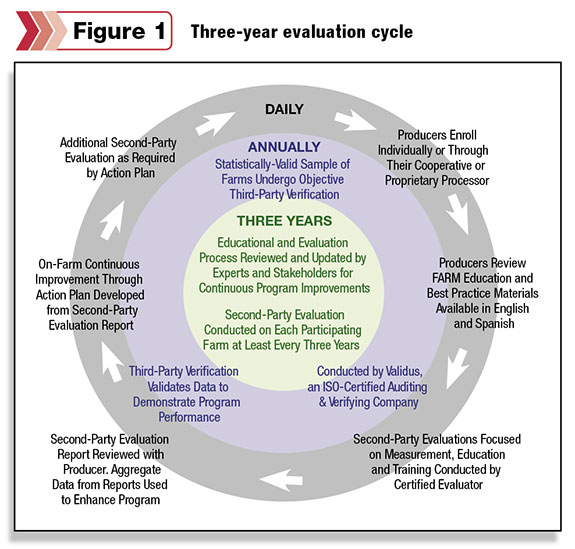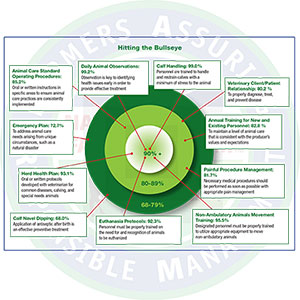The most commonly asked question of any 3-year-old is “Why?” It displays their curiosity to learn more about the things they already know in life. In its third year, the National Dairy FARM Animal Care Program is also busy asking “Why?”

When this national set of guidelines designed to demonstrate dairy farmers’ commitment to outstanding animal care and a quality milk supply was first constructed, it was determined that every three years an educational and evaluation process review would take place to continually improve the program.
The review is an opportunity to evaluate and revise the animal care guidelines for dairy farms to follow and the observation protocol the evaluators use.
Experts and stakeholders began this revision process last May, looking carefully to see if any items were redundant or if something new needs to be added.
In the final edit stage, Betsy Flores, senior director of animal health and welfare for National Milk Producers Federation (NMPF), says it is too early to release the official changes.
However, she did say there would be some tightening up of the process, with some of the guidelines tweaked just a bit. The core areas for observation will most likely remain the same.
The review helps to keep the program in line with the latest scientifically approved welfare practices, which is important as cooperatives, proprietary milk processors and individual dairy producers are using it to assure consumers that the food they purchase is produced with integrity.
“The need is out there,” Flores says. “We’ve had several new processors and cooperatives come on since the first of the year.”
As of September 1, 2012, the FARM Program had 36 cooperatives and proprietary processors, and dozens of individual dairy producer participants, which accounted for 41 percent of the nation’s milk supply.
With the recent additions, the program covers 46 percent of the supply.
As enrollment continues to gain momentum, NMPF anticipates participation in the program to exceed 70 percent of milk in the country.
With it being a relatively young program, it is hard to gauge at this time the effect it has had on the entire industry, but Flores says individual farms are benefiting from the process.
“Even the top dairies still get something out of this process,” she says. “The on-farm evaluator could see something the farmer might miss.”
Overall, the program is verifying what many have already known: Dairy farms are doing a good job of taking care of their animals.
The program is compiling data from the on-farm evaluations to look at the industry on a national scale. The analysis demonstrates that producers take the responsibility for the well-being of animals under their care very seriously.
More than 99 percent of farm operators engage in observing animals to identify potential health issues. The same number train their personnel to handle and restrain calves with minimal stress to the animal.
Almost as many (95.5 percent) also train their employees on how to properly move non-ambulatory animals.
Of course, there is always room for improvement. Fewer than 70 percent of farmers apply antiseptic to the navels of calves after birth. Only slightly more (72.7 percent) have emergency plans to address animal care needs in the event of a disaster.
 The figure at right showcases how dairies participating in FARM perform on key best practices. Click here or on the image at right to view it at full size.
The figure at right showcases how dairies participating in FARM perform on key best practices. Click here or on the image at right to view it at full size.
Flores notes the creation of an emergency plan is easy to address. It requires taking a moment to write down names and phone numbers of who to contact in the event of an emergency. Something as simple as the number of the fire department and even 911 is a good place to start.
A topic that is a bit more complex is pain management on the farm. This area has received a lot of emphasis from outside the industry, Flores says.
Farms should get in the habit of reviewing their pain management procedures and asking if it is correct or if it should be changed.
“Most producers might be on the right track, but it doesn’t hurt to set up an appointment every year to talk with your veterinarian to go over vaccination and treatment protocols,” she says.
Pain management and certain other farm practices can be difficult to discuss for a variety of reasons, but Flores has heard from cooperatives, processors and evaluators that this process opens up opportunities for those conversations.
Sometimes the field staff or veterinarians have wanted to address a subject with the farm but were not comfortable about bringing it up, she says. Now since it is part of the evaluation, it can be more easily discussed when sharing the farm’s results.
In addition, because producers and evaluators typically have some sort of relationship going into the evaluation, there is a comfort level between the two that allows for open-minded sharing, Flores says.
On the purchasing side of the industry, most grocers, restaurants, etc., that Flores hears from are happy the dairy industry is being proactive. “They are very pleased the dairy industry has stepped up to the plate to create a program that is third-party verified and is credible,” she says.
That credibility is an important part of the program, which is one of the reasons the national dairy checkoff has agreed to cover the cost of third-party verification for the next three years. Previously, participation fees were charged to pay for the verification.
While every farm that takes part in the program completes a second-party on-farm evaluation, only a statistically valid sample of farms is used for the third-party verification.
In 2012, that number was 89 farms. In the third-party format, the farm is re-evaluated only for the purpose of verifying the original evaluator did their job accurately and consistently compared to others in the program.
The most recent round of third-party verification was completed in December. The data has been sent to a statistician and a report should be released soon.
Parents of 3-year-olds can often get annoyed with the asking of “Why?” Yet it’s a question that can yield some very good answers. PD

Karen Lee
Editor
Progressive Dairyman




